| / We will do attentively.. | Collection / Supposes / E-mail / Site map |

|
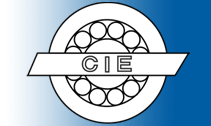
| Industry News | |||||||
|
| Basic Technical Parameter |
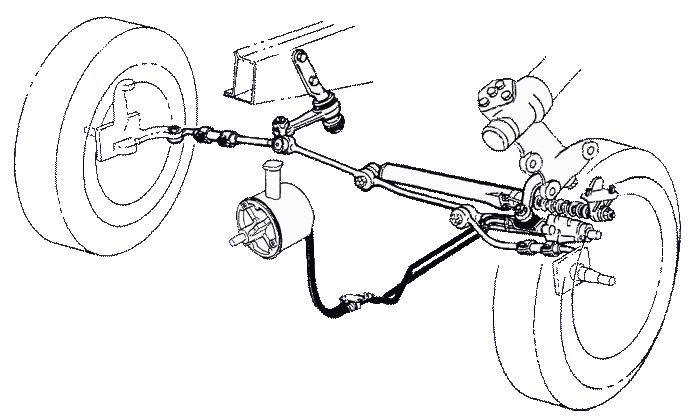 |
The power steering system, as used on many early Fords from the mid 50's into the early 80's, was technically a power assisted system, meaning that a stock-style steering linkage had this system "added on" to ease the steering effort while turning the car.
A true power steering system uses a hydraulically powered steering box to provide power to the linkage. This power-assist system was also used on many GM and Chrysler cars and is actually a simple and efficient system. It is usually found on smaller and lighter models of cars but was also used for some time on larger and heavier cars such as the early 60's Galaxies and Mercurys. While some of the components have slightly different configurations and cosmetic changes, all the Ford systems operate the same way.
The Ford power-assist system was composed of three major hydraulic components that worked together to help steer the car, the Pump, the Control Valve and the Power Cylinder. The Pump is belt-driven off the front of the engine and provides hydraulic fluid under pressure to power the system. The Control Valve directs the fluid to the proper source in order to turn the car in the direction required, and the Power Cylinder pushes or pulls the linkage the direction needed to turn the car as directed. These three components are connected together by hydraulic hoses which carry the fluid under pressure through the system. The power system itself is contained in these few parts.
The Pump uses power taken from the engine to compress hydraulic fluid to be used by the system. This fluid not only acts as a hydraulic fluid but also lubricates and cools the components. Early Ford systems used an Eaton Pump for the job. This pump is very simple in design and was also used by many other car manufacturers. Its pumping action is provided by a five-fingered rotor which propel five loose metal rollers inside an eccentric chamber to provide pressure. A very simple and "loose" design, the Eaton pump could probably pump mud without much problem. The Eaton Pump is a stand-alone pump that had the fluid reservoir mounted either on top of the pump or remotely on the fender apron. Typically, non-airconditioned Fords had the reservoir mounted on top of the pump, while air conditioned cars had a reservoir mounted on the fender apron and connected to the pump by a hose. This later arrangement was needed since the reservoir would not clear the air conditioning compressor. While this style of system is considered "old fashioned" today, many new cars from Ford are again using a remote reservoir system. After about 1965, Ford went to the Ford/Thompson style pump, so named because the pump was a TRW design pump. This style has the pump mounted inside a round metal canister which doubles as a reservoir. It uses eight spring-loaded slippers to compress fluid and provide pressure. A much tighter design than the Eaton Pump, the Ford/Thompson Pump (hereafter refered to as the Ford Pump), could provide better pressure at low speed (idle) and higher pressure when needed. |
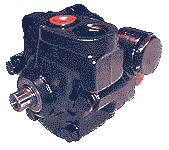 |
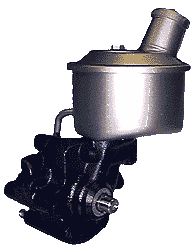 |
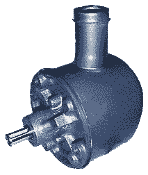 |
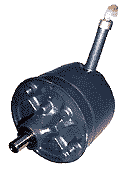 |
EATON PUMP without reservoir |
EATON PUMP with reservoir |
FORD PUMP Large Neck 1965-1966 |
FORD PUMP Small Neck 1967-1977 |
The Control Valve receives pressurized fluid from the pump and directs it to the proper place to cause the wheels to turn in the desired direction. The Control Valve actually consisits of two parts: the Ball Stud Sleeve and the Valve Housing. The Ball Stud Sleeve connects to the drivers side end of the Centerlink, also known as a Drag Link. In some models the Sleeve screws directly onto the end of the Centerlink. In others it screws onto an Extension that itself is bolted to the end of the Centerlink. Out of the top of the Ball Stud Sleeve sticks the Ball Stud itself, which is connected to the Pitman Arm coming off of the Sector Shaft of the Steering Box. The Ball Stud sits inside the Ball Stud Bushing, sandwiched between two spring-loaded Ball Stud Seats that allow the Ball Stud to swivel around enough to keep it from binding when the steering linkage is moving. It is important to know that the Ball Stud is not held in place inside the Sleeve only by the Seats, but by the lip of the Bushing where it goes around the ball end of the Ball Stud. The Sleeve bolts onto the Valve Housing. Inside the Housing is a Spool Valve which slides back and forth inside the Housing. This Spool Valve covers and uncovers passages in the Housing that sends the fluid to various outlet ports on the Housing. The fluid then moves through hoses from the Housing to the Power Cylinder. This cylinder has an internal cylinder that has fluid on both sides of a piston. Depending on which hose the Control Valve sends pressurized fluid through, this piston is forced in or out of the cylinder. The piston is connected to a rod which comes out of the Cylinder and has one end attached to the frame rail of the car. When the piston and rod move back and forth, they alternately push and pull against the frame of the car. Since the outer housing of the Cylinder is connected to the Centerlink, this pushing and pulling force the Centerlink and steering lingage back and forth, thus turning the car. Fluid not used in the Cylinder is sent back to the Housing and from there back to the Pump reservoir. |
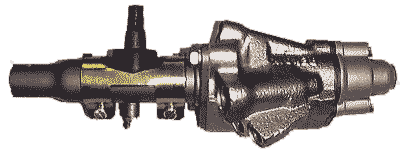 |
BALL STUD
BALL STUD ASSEMBLY
CONTROL VALVE
|
With the engine running, the system has fluid circulating through it, just sitting there waiting for action. When you turn the steering wheel, the Ball Stud becomes uncentered in the Sleeve and causes the Spool Valve to direct fluid to the Cylinder. The action of the Cylinder moves the steering linkage until the Ball Stud is centered again in the Sleeve, after which the whole system sits waiting again. The entire operation consists of the hydraulics trying to keep the Ball Stud centered in the Sleeve.Uncenter the Ball Stud and the linkage moves to recenter it again. It is just a circumstance of this action and reaction that the cars wheels turn by power assist. Simple. |
In defense of the Power Assist Steering System ... |
| While the power-assist system does not have the efficiency, tightness or road-feel of a modern day rack-and-pinion system, it is still a very good system and was considered state-of-the-art in its day. Good enough to be installed on millions of cars including high performance vehicles like the Shelby Mustang and Chevrolet Corvette. People have been spoiled by modern rack and variable ratio systems. They do not understand how an early system is supposed to feel and operate. True, a rack system is simpler and has a tighter feel to it, but a power assist system with a proper condition steering box and steering linkage is almost as good. A power assist system reacts immediately to driver input while modern systems are designed to be slower and heavy feeling in comparison. This is not a problem of the system but a problem of the driver who does not know what to expect of an assisted system or how to drive it. And properly rebuilt, assembled and maintained, a power asisst system will not leak. There are simply more places where an assisted system can leak, but this is not a flaw of the system, but just the difference between early and more modern systems. |
| Workshop | Products | Contact |
| Copyright © NINGBO CIE INDUSTRY AND TRADE CO.,LTD. All Rights Reserved. Design By HiSupplier Online Inc. |
